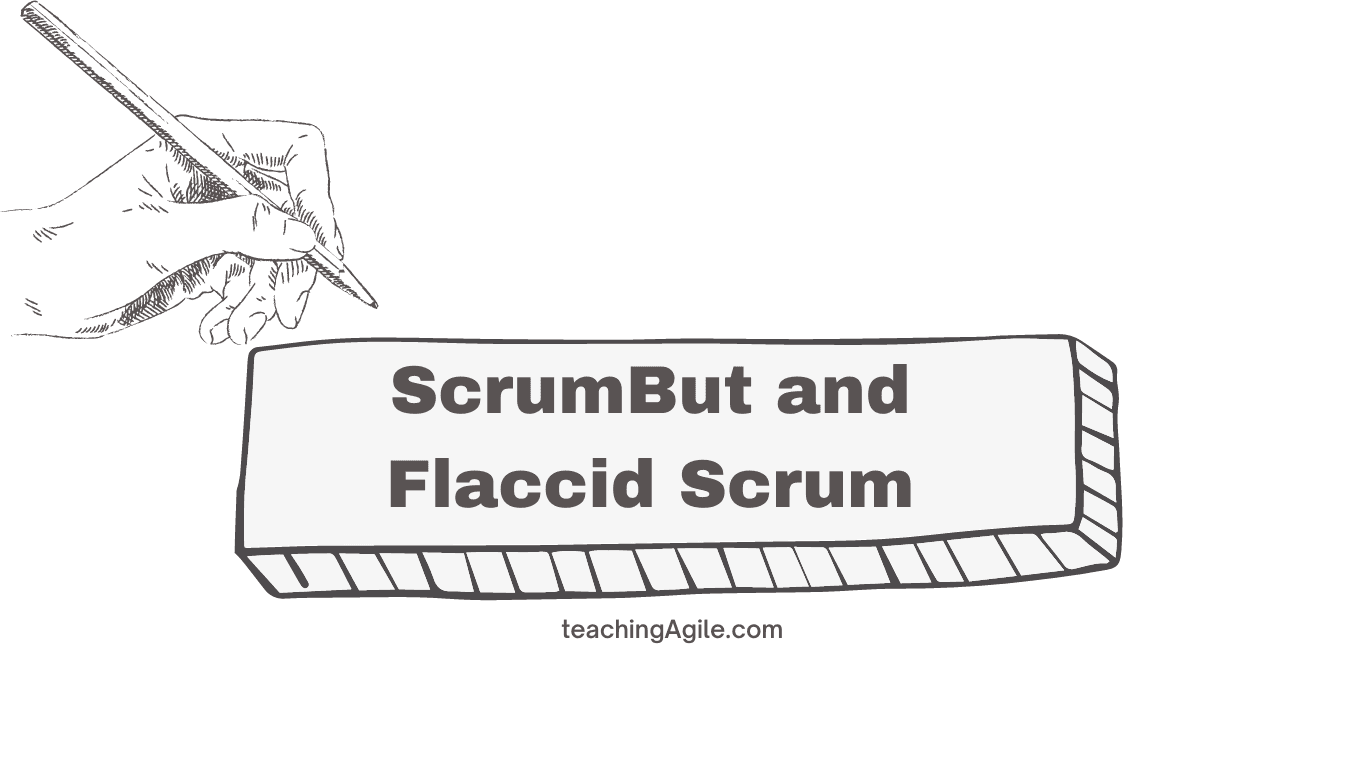
ScrumBut and Flaccid Scrum: Pitfalls to Avoid in Your Agile Journey.
 ScrumBut and Flaccid Scrum
ScrumBut and Flaccid Scrum
As organizations embrace Agile methodologies and Scrum to improve their processes, some may fall into the trap of ScrumBut and Flaccid Scrum.
Both the concepts of "ScrumBut" and "Flaccid Scrum", while highlighting potential roadblocks, serve as important reminders of the discipline needed to fully leverage the benefits of the Scrum framework.
Flaccid Scrum surfaces when a team, despite adopting Scrum practices, doesn't fully attain its benefits.
On the other hand, ScrumBut occurs when teams unknowingly dilute the potency of Scrum by bypassing or modifying its principles.
Recognizing these challenges is the first step towards fortifying your Scrum practices. In this article, we will explore ScrumBut and Flaccid Scrum, their common symptoms, and how to overcome them to reap the full benefits of Agile.
Table Of Contents-
What is ScrumBut?
ScrumBut refers to using Scrum "but" with exceptions, modifications, or shortcuts that deviate from the established framework.
ScrumBut occurs when a team claims to follow Scrum while making changes that undermine the framework's principles and values. This partial adoption of Scrum can lead to inefficient processes, reduced transparency, and a lack of commitment to improvement.
What is Flaccid Scrum?
Flaccid Scrum is a term coined by Martin Fowler (opens in a new tab) to describe teams that adopt the Scrum framework but fail to follow essential engineering practices.
As a result, they need help to deliver high-quality, working software consistently. Flaccid Scrum can lead to technical debt, longer development cycles, and an inability to respond to change effectively.
Common ScrumBut and Flaccid Scrum Symptoms
Some common symptoms of ScrumBut and Flaccid Scrum include:
- Inconsistent use of Scrum events: Skipping or shortening Scrum events, such as Daily Scrums or Sprint Retrospectives, undermines their purpose and reduces opportunities for inspection and adaptation.
- Poorly defined roles: Not clearly defining or respecting Scrum roles can lead to confusion, diluted responsibilities, and a lack of accountability.
- Neglecting the Definition of Done: Failing to establish or adhere to a clear Definition of Done can result in incomplete work, technical debt, and an inability to deliver a potentially releasable Increment.
- Lack of commitment to continuous improvement: Ignoring or delaying the implementation of improvements identified during Retrospectives hinders a team's ability to learn and grow.
- Ignoring engineering best practices: Neglecting essential engineering practices, such as test-driven development, continuous integration, and refactoring, can result in low-quality software and increased technical debt.
Overcoming ScrumBut and Flaccid Scrum
To overcome ScrumBut and Flaccid Scrum, consider the following steps:
- Commit to the Scrum framework: Ensure your entire team consistently understands the importance of following Scrum principles, values, and practices consistently.
- Clarify roles and responsibilities: Clearly define and communicate the duties of the Scrum Master, Product Owner, and Development Team to avoid confusion and improve accountability.
- Establish and enforce a Definition of Done: Create a clear and shared Definition of Done that sets the standard for quality, completeness, and completeness and ensures that the team consistently follows it.
- Embrace continuous improvement: Identify and implement improvements during Retrospectives to enable your team to learn, grow, and become more efficient.
- Adopt engineering best practices: Integrate engineering practices such as test-driven development, continuous integration, and refactoring to improve software quality and reduce technical debt.
- Seek external guidance: If your team is struggling with ScrumBut or Flaccid Scrum, consider seeking help from experienced Agile coaches, mentors, or trainers who can provide valuable insights and guidance.
| Symptoms of ScrumBut and Flaccid Scrum | Solutions to Overcome ScrumBut and Flaccid Scrum |
|---|---|
| Inconsistent use of Scrum events | Commit to the Scrum framework and regularly hold Scrum events |
| Poorly defined roles | Clarify roles and responsibilities within the Scrum framework |
| Neglecting the Definition of Done | Establish and enforce a clear and shared Definition of Done |
| Lack of commitment to continuous improvement | Embrace the continuous improvement cycle, especially during Sprint Retrospectives |
| Ignoring engineering best practices | Adopt and adhere to essential engineering practices |
Table: Symptoms of ScrumBut and Flaccid Scrum and Solutions to overcome them
By understanding the symptoms and their corresponding solutions, you can make significant strides in overcoming ScrumBut and Flaccid Scrum, ultimately improving your team's performance and product outcome.
Conclusion
💡
ScrumBut and Flaccid Scrum are pitfalls that can hinder the success of Agile teams and prevent them from realizing the full benefits of the Scrum framework.
Flaccid Scrum and ScrumBut represent common pitfalls teams may encounter when adopting the Scrum framework.
Yet, they also provide valuable opportunities for reflection and growth.
Overcoming these challenges requires a steadfast commitment to the core principles and values of Scrum. With the right blend of discipline, agility, and continuous learning, your team can avoid these potential roadblocks and fully harness the power of Scrum.
In your Agile journey, remember that the focus should always be on delivering value, fostering collaboration, and achieving continuous improvement. Ultimately, it's not just about 'doing' Scrum, but about 'being' Agile.